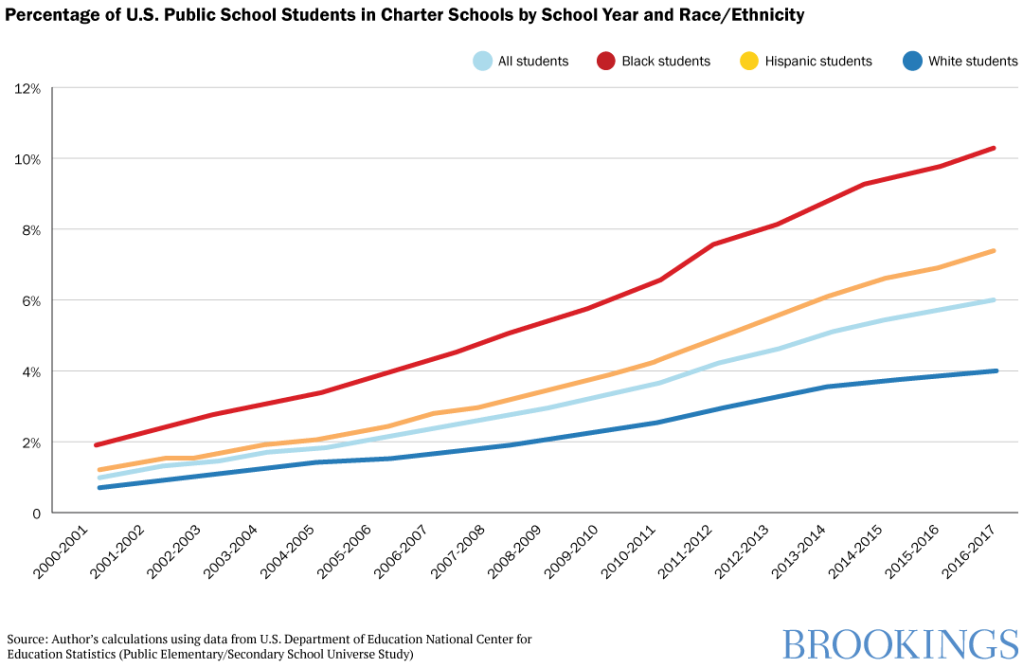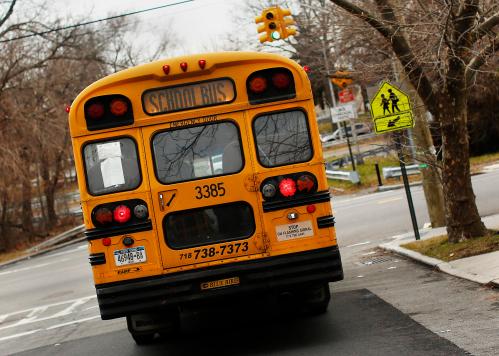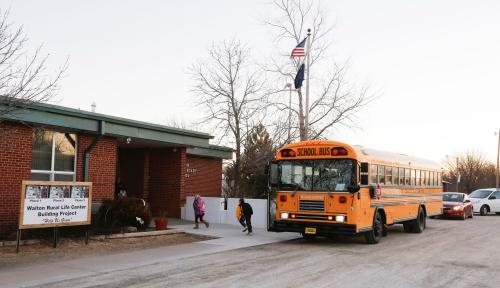The Vitals
Charter
schools are tuition-free, publicly funded schools. Charter school leaders
accept greater accountability in exchange for greater autonomy. About 3 million
students attend charter schools across 43 states and the District of Columbia.
Assessing whether charter schools work is a complicated question. While the
last four U.S. presidents—Clinton, Bush, Obama, and Trump—all expressed support
for charter schools, support is splintering along party lines.
-
About 3 million students attend charter schools across 43 states and the District of Columbia.
-
Compared to traditional public schools, a disproportionate share of charter school students are Hispanic (33%) or Black (26%).
-
Assessing whether charter schools work is difficult because doing so requires clarity about their goals and good measures of how well they achieve those goals.
Watch
A Closer Look
What is a charter school?
Traditionally,
local school districts operate public schools. They make decisions about how
schools run, in some cases through collective bargaining agreements with
teachers unions. Most students are assigned to traditional public schools based
on the neighborhood in which they live.
Charter
schools operate differently. A charter school begins with an application that
describes the proposed school’s mission, curriculum, management structure,
finances, and other characteristics. That proposal goes to a
government-approved authorizing agency such as a school district or a university.
Who can serve as an authorizer—like many aspects of charter school law—varies
from state to state. If the authorizer approves the proposal, it creates a
contract (“charter”) with the school’s governing board that describes the
school’s rights, responsibilities, and performance expectations. This is the core
of what has been called the “charter school bargain.” School leaders accept greater
accountability (e.g., the possibility of closure for poor performance) in
exchange for greater autonomy (e.g., the ability to pursue a specialized theme).
Along with
accountability and autonomy, the other principle at the foundation of the
charter school model is choice. Students are not assigned to charter schools
based on where they live. Instead, their families request a seat in the school.
Some cities use unified
enrollment systems that allow families to request many schools at
once, ranked in order of preference, and then assign students to schools using
a placement algorithm.
The
principles of accountability, autonomy, and choice are interconnected. For
example, choice serves as a form of market accountability (since schools must
attract families to stay open), while school leaders can use their autonomy to differentiate
themselves and create a rich assortment of choices for families.
Why are charter schools controversial?
Since their
formative days in the early 1990s, charter schools have drawn support from
unusual political coalitions, with different groups seeing different opportunities.
Many conservatives like the market competition and limited government control. Many
progressives like that all families, not just the wealthy, get to choose their
children’s schools. Even some union leaders saw early promise in charter
schools as a way to give teachers more voice in how schools run. In fact, the last
four U.S. presidents—Clinton, Bush, Obama, and Trump—all expressed support.
However, the
politics of charters are changing. Teachers unions have long been charter
schools’ most powerful opponents—they are skeptical that charter school
teachers actually have more control and frustrated that only
11% of charter schools employ unionized teachers. More generally,
support is splintering along party lines as Democrats—especially
white progressives—have become increasingly opposed. Some of this
polarization predates the Trump administration. For example, many prominent
Democrats, including Senators Elizabeth Warren and Bernie Sanders, opposed a 2016
Massachusetts referendum to allow more charter schools (a referendum that was
soundly defeated). However, the emergence of President Trump and Secretary of
Education Betsy DeVos as the most prominent charter school supporters has accelerated
the polarization in public opinion.
The specific
critiques of charter schools vary. For example, some dislike that charter
schools attract public funding (and students) that otherwise would have gone to
traditional public schools. Others dislike that for-profit education management
organizations can operate charter schools in some states (about
12% of charter schools had this status in 2016-17, according to the
National Alliance for Public Charter Schools). Others worry about a lack of transparency
or public control—or that charters haven’t
lived up to their promise.
Who attends charter schools?
Despite the attention these schools get, only about 6% of U.S. public school students attended a charter school in 2016-17. As illustrated by the light blue line in the figure below, this percentage has increased since the turn of the century, although the rate of growth appears to be tapering off.

Notably, a
disproportionate share of charter school students are either Hispanic (33%
of all charter students) or Black (26%). More than 10% of Black
public school students and 7% of Hispanic public school students attended a
charter school in 2016-17, compared to about 4% of white students.
This
partly reflects the fact that a much larger share of charter schools (57%) than
traditional public schools (25%) are operating in cities.
In many
cities, including Detroit and Washington, D.C., a majority or near-majority
of public school students attend a charter school. At the extreme end of the
spectrum, New Orleans has an all-charter public school system.
Do charter schools work?
Assessing
whether charter schools work requires clarity about their goals and good
measures of how well they achieve those goals. It is not clear that we have
either.
The most
commonly reported studies compare students’ academic performance in charter versus
non-charter schools. These comparisons are methodologically challenging, since charter
school students differ from other public school students in ways that could
affect their performance. Researchers need to find reasonable comparison groups.
One
approach is to examine the random lotteries often used when a school receives
more applicants than it can accommodate. Researchers tend to find that lottery winners
perform much better than lottery losers, but these comparisons come with major
caveats. Only schools with excess demand conduct lotteries, and it’s no
surprise that students who get into the most sought-after schools perform well.
The Center
for Research on Education Outcomes (CREDO) at Stanford University has taken a
different approach. CREDO obtains student-level data from many states and
districts and then matches charter school students with traditional public
school students who appear similar in many ways (e.g., students of the same
race, gender, and poverty status, with similar prior test scores, who
previously attended the same schools). Then they compare charter students’ test
scores with the scores of their matched non-charter pairs. This method isn’t
foolproof—for example, the variables used for matching could miss something
important—but it is probably the best approach to date for charter/non-charter
comparisons that represent the broad population of charter schools.
The figure below shows some notable results from the CREDO studies. The key takeaway is that charter school students, in general, perform about the same as their matched peers in the traditional public schools, but there is variation across different types of schools and groups of students. For example, students in urban charter schools generally perform better than their matched pairs—likely for an assortment of reasons—while students in online charter schools perform much worse.

However, we
should consider whether a charters versus traditional public schools comparison
is the right measure in the first place. Part of the rationale for charter
schools is that they should generate innovation and competitive pressure that improve
charter and non-charter schools alike. If those improvements occur—and there is
some
evidence for this—these comparisons might understate the benefits of
charter schools. If charter schools harm traditional public schools by, for
example, reducing funding or creating funding uncertainty—and there is some
evidence for this, too—these comparisons might understate the costs
of charter schools.
Regardless,
test score comparisons paint an incomplete picture of charter school
performance. We care about a much broader set of outcomes, including how
charter schools affect racial segregation, to what extent they create options
for disadvantaged families, and whether they are truly producing innovative
school models. The related research is too expansive for this overview but summarized
nicely in a 2015 NBER report.
What can policymakers do at the federal level?
When
presidential candidates talk about charter schools, it is more about politics
and principle than policy, since education is largely left to the states.
However, the federal government plays a role. For example, the U.S. Department
of Education administers the Charter Schools Program (CSP), which provides funds
to assist with matters such as charter school start-up, facilities acquisition,
and replication. Congress allotted $440 million for the CSP in FY 2019—a figure
that has increased substantially during the Trump administration. Federal
policymakers could increase or decrease overall funding and add or remove stipulations
for that funding (e.g., keeping federal funds from reaching for-profit charter
schools).
State and
local policymakers regularly make consequential decisions about charter schools.
These decisions cover a wide range of issues, including funding formulas, caps
on the number of schools or seats allowed, determinations of which schools (or
types of schools) to open, rules about which students get priority access to
high-demand schools, and requirements for open meetings and records.








Commentary
What are charter schools and do they deliver?
October 15, 2019